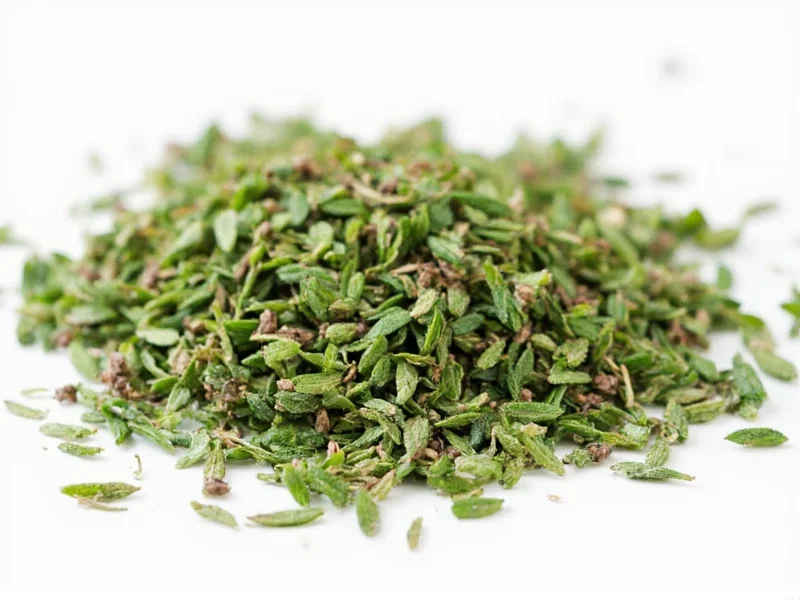When adapting recipes that call for fresh thyme but you only have dried thyme available (or vice versa), understanding the proper conversion ratio is essential for achieving balanced flavors in your dishes. The standard culinary guideline states that dried herbs are approximately three times more potent than their fresh counterparts due to the removal of water content during the drying process. This means when substituting dried thyme for fresh, you should use one-third the amount specified in the recipe.
Understanding the Fresh to Dried Herb Conversion Ratio
The 3:1 conversion ratio between fresh and dried herbs isn't arbitrary—it's based on scientific principles of flavor concentration. Fresh thyme contains about 85% water, which evaporates during the drying process. What remains is a more concentrated form of the essential oils and flavor compounds that give thyme its distinctive aroma and taste.
Professional chefs and culinary experts consistently recommend this ratio because it prevents dishes from becoming overpowering or bitter. Using equal amounts of dried thyme in place of fresh would result in a dish that's three times too strong, potentially ruining your carefully prepared meal.
Practical Application in Your Kitchen
When converting measurements for your recipes, remember these practical guidelines:
- For every 1 teaspoon of dried thyme, use 3 teaspoons (1 tablespoon) of fresh thyme
- For every 1 tablespoon of dried thyme, use 3 tablespoons of fresh thyme
- When in doubt, start with less dried herb and adjust to taste during cooking
- Add dried herbs earlier in the cooking process to allow time for rehydration
- Add fresh herbs toward the end of cooking to preserve their delicate flavor
| Measurement | Fresh Thyme | Dried Thyme |
|---|---|---|
| Pinch | 1/4 teaspoon | 1/12 teaspoon |
| 1 teaspoon | 1 teaspoon | 1/3 teaspoon |
| 2 teaspoons | 2 teaspoons | 2/3 teaspoon |
| 1 tablespoon | 1 tablespoon | 1 teaspoon |
| 2 tablespoons | 2 tablespoons | 2 teaspoons |
Flavor Profile Differences Between Fresh and Dried Thyme
While the conversion ratio provides the mathematical equivalent, it's important to understand that fresh and dried thyme don't offer identical flavor experiences. Fresh thyme has brighter, more floral notes with subtle citrus undertones, while dried thyme develops deeper, earthier characteristics with slightly more pronounced pine-like flavors.
These flavor differences mean that while the 3:1 ratio works well for most applications, certain dishes might benefit from slight adjustments. For example, in delicate sauces or finishing dishes, you might want to use slightly less dried thyme than the standard conversion suggests. Conversely, in hearty stews or long-simmering dishes, you might need to increase the dried thyme by a small amount to compensate for flavor loss during extended cooking.
Storage Considerations for Optimal Flavor
The age and storage conditions of your dried thyme significantly impact its potency. Properly stored dried thyme maintains peak flavor for about 6-12 months, after which it gradually loses potency. Store dried thyme in an airtight container away from heat, light, and moisture to preserve its flavor.
Fresh thyme, when properly stored in the refrigerator with stems in water (like flowers) and covered with a plastic bag, can last up to two weeks. For longer storage, freeze fresh thyme sprigs in ice cube trays with water or olive oil.
When to Choose Fresh vs. Dried Thyme
Certain dishes benefit from one form over the other. Fresh thyme excels in:
- Salads and fresh vegetable dishes
- Finishing sauces and soups
- Grilled meats and vegetables
- Cold preparations like vinaigrettes
Dried thyme works best in:
- Long-simmering stews and braises
- Dry rubs for meats
- Baked goods and breads
- Spice blends and seasoning mixes
Common Substitution Mistakes to Avoid
Many home cooks make these common errors when substituting thyme forms:
- Using equal measurements instead of adjusting for potency
- Adding dried herbs at the same stage as fresh herbs
- Not accounting for the age of dried herbs (older = less potent)
- Crushing dried thyme between fingers before adding (releases too much oil at once)
- Using thyme stems interchangeably (fresh stems are often too woody to eat)
For the most accurate results when converting between fresh and dried thyme, always measure dried herbs with proper measuring spoons rather than estimating. The difference between 2/3 teaspoon and 3/4 teaspoon might seem small, but in delicate dishes, it can significantly impact the final flavor profile.











 浙公网安备
33010002000092号
浙公网安备
33010002000092号 浙B2-20120091-4
浙B2-20120091-4